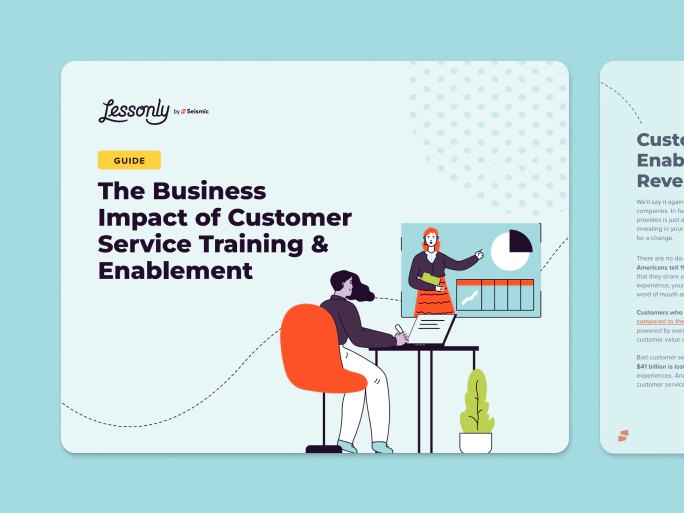What is call center training?
Call centers support an organization’s customers through customer service agents, commonly using the phone, email, or chat messaging. Despite the rise of self-serve channels for consumers, a study by McKinsey and Company shows that people still prefer connecting with real humans to get answers and assistance for more complex questions.
In order for organizations to deliver high-quality support to customers, agents need access to ongoing learning and development through call center training programs. Call center training provides agents with the resources, knowledge, and skills needed to ensure excellent customer service and business growth.
Did you know?
Customer satisfaction drops by 15% every time a customer has to call back about the same issue.
The importance of call center training
Call center training isn’t just a box to check. It’s an investment in your employees and your business that serves to improve the customer experience and reduce turnover. Here are just a few of the benefits you’ll see with a strong training program:
Lower agent attrition
Training programs can mitigate employee turnover by improving job satisfaction. In fact, agents who feel supported in their role are nearly 70% less likely to feel burnout. Like many other industries, turnover in the customer service industry has also increased over the past 12 months, so training is a critical investment in decreasing the cost of sourcing and getting new agents up to speed.
Improved agent performance
Call center training programs hone customer service skills, enabling agents to provide faster support and resolution times which ultimately leads to business growth.
Increased productivity
Reps with the correct training are less likely to place a customer on hold. With 67% of customers saying they would only accept a wait time of less than two minutes, it’s clear that boosting rep productivity helps them better serve their customers.
Deliver superior service
Customer satisfaction drops by 15% every time a customer has to call back about the same issue. By delivering call center training programs that provide agents with the right knowledge and skills to solve customer questions, you’ll see performance improvements that make a real impact on your bottom line.
How to structure each stage of call center training
While there are many different ways to approach a call center training program, it should include onboarding, shadowing, coaching, and ongoing training.
1
Phase 1: New agent onboarding
2
Phase 2: Shadowing
3
Phase 3: Nesting and coaching
4
Phase 4: Ongoing training
The Impact of Customer Service Training

Effective call center training methods
In the past, call center training programs were mostly delivered through in-person classroom-style training. This training method required both new and experienced agents to sit through lengthy training sessions and listen to a trainer deliver content through presentations. But now, with the major shift toward remote and hybrid work, in-person training is no longer a practical or effective training method for call centers. Instead, call centers need to embrace a more modern approach to training that gives agents the opportunity to access and engage with training when and where it’s best for them.
By embracing online training, call center leaders can effectively train both new and experienced agents at scale. Trainers can create call center training modules that agents can access and complete on-demand. These modules deliver consistent training materials which is crucial to ensuring a steady level of service from every agent. It’s also a more engaging training method as it supports customer service training videos, assessments, knowledge checks, and quizzes.
Online call center training courses are a great way to deliver training to remote agents. Online training also enables leaders to better measure the completion and success of their program. These tools give trainers the ability to track agent training progress over time and deliver ongoing feedback and coaching as needed.
Must-have call center training topics
Now that you understand how beneficial online customer service can be, it’s important to note that there are a number of customer service topics that every agent needs to know. So, when it comes to designing and creating your call center training program, be sure to include these important topics.
- Product and service knowledge: This is foundational information for every new call center agent that should be covered during onboarding and refreshed as product offerings change or grow.
- Customer service policies: Every organization has standard policies and procedures that every agent must follow. Customer service policy training covers topics such as return policies, timeframe for support, and more to ensure that agents deliver consistent and standardized support across the organization.
- Customer service standards: Training on the dos and don’ts of customer service might include phrases to avoid and how to approach a difficult customer. You may also choose to develop a subset of training that focuses specifically on de-escalation in call centers.
- Tools, systems, and workflows: This will include training on the software (and sometimes hardware) that agents use, as well as day-to-day workflows.
- Soft skills: Soft skills like active listening, communication, empathy, and flexibility, are critical for successful customer service. Call center soft skills training can include fun, interactive exercises and games where agents can practice their skills and receive feedback.
- Sales skills: In many of today’s call centers, agents are also being tasked with selling or up-selling products to customers. If this is the case for your organization, your call center agents also need training on sales skills, such as pitching, negotiation, and pricing.
- Best practices for support channels: Nearly every organization provides omnichannel support which means that agents need training for each channel. While every organization should provide call center phone training, it’s also important to enable agents for success on different channels. For example, if your agent also interacts with customers through chat or email, it’s best to provide effective communication training for each channel.
Designing your call center training program
Assess current training and identify needs
Your current training may need a small update or a complete overhaul. Either way, start by reviewing your current training program, and identify gaps and opportunities for improvement. Are wait times too high? Is customer satisfaction too low? Are agents unhappy? Use these challenges to inform focus areas for your future plan.
Plan your program
Start your plan with a call center training outline that includes:
- Goals: What are the measurable outcomes you hope to achieve? Consider quantitative metrics on attrition, productivity, and customer satisfaction.
- Training topics: From product and service training to soft skills, include all of the major learning areas agents will be trained on.
- Formats: Include a mix of formats, such as online training videos, written texts, and 1:1 coaching.
- Timelines: Put a clear timeframe on training, such as 3 to 6 weeks for the initial phase. Think beyond onboarding on how you’ll create a continuous training experience.
Build your training materials
After you create your call center training program outline, it’s time to build or update the training materials to support it. Create a calendar that staggers the work over a period of time and makes it achievable for your team while ensuring it’s all completed by a target date.
Train agents faster.
Call center training best practices
In helping hundreds of global customer service teams design effective call center training programs, we’ve identified a few core best practices to keep in mind:
Embrace ongoing learning and coaching
Call center agent training doesn’t end after onboarding. Make sure that your training includes ongoing learning opportunities, as well as 1:1 coaching and feedback for agents.
Improve performance through practice
While it can sometimes feel slightly uncomfortable, one of the best learning tools is role-play that focuses on testing soft skills and relevant customer challenges. This can be done over the phone or in-person and provides a low-stakes environment for agents to practice challenging conversations or interactions.
Track progress
If you don’t measure progress, it’s very challenging to understand an agent’s performance over time. From the very start, set clear metric-based goals they’ll be monitored on, and keep an eye on progress over time. Give feedback regularly.
Provide on-demand access
Call center agents can have variable hours — and it’s almost impossible to schedule live trainings that everyone can attend. Offer on-demand call center training courses so they can access it during a time that works for them.
Iterate and update
The worst plan is a stagnant plan. As you launch your call center training, take note of what’s working and what’s not. Update your training plan over time, and add new resources as needed.
Deliver better call center training with Seismic
At Seismic, we’re here to support you in building and managing your call center training program. Our online learning and coaching software allows you to organize and deliver call center agent training, as well as monitor and measure the progress of your agents. With Seismic, customer service teams can ramp agents quickly, hone essential soft skills, and improve key performance metrics. Ready to learn more? Click here to read how Symplicity decreased new agent ramp time and improved CSAT scores by delivering training and coaching with Seismic. Or, see the platform in action for yourself. Get a demo here.



